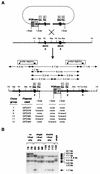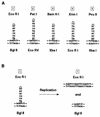Analysis of gene targeting and intrachromosomal homologous recombination stimulated by genomic double-strand breaks in mouse embryonic stem cells
- PMID: 9632791
- PMCID: PMC108991
- DOI: 10.1128/MCB.18.7.4070
Analysis of gene targeting and intrachromosomal homologous recombination stimulated by genomic double-strand breaks in mouse embryonic stem cells
Abstract
To investigate the effects of in vivo genomic DNA double-strand breaks on the efficiency and mechanisms of gene targeting in mouse embryonic stem cells, we have used a series of insertion and replacement vectors carrying two, one, or no genomic sites for the rare-cutting endonuclease I-SceI. These vectors were introduced into the hypoxanthine phosphoribosyltransferase (hprt) gene to produce substrates for gene-targeting (plasmid-to-chromosome) or intrachromosomal (direct repeat) homologous recombination. Recombination at the hprt locus is markedly increased following transfection with an I-SceI expression plasmid and a homologous donor plasmid (if needed). The frequency of gene targeting in clones with an I-SceI site attains a value of 1%, 5,000-fold higher than that in clones with no I-SceI site. The use of silent restriction site polymorphisms indicates that the frequencies with which donor plasmid sequences replace the target chromosomal sequences decrease with distance from the genomic break site. The frequency of intrachromosomal recombination reaches a value of 3.1%, 120-fold higher than background spontaneous recombination. Because palindromic insertions were used as polymorphic markers, a significant number of recombinants exhibit distinct genotypic sectoring among daughter cells from a single clone, suggesting the existence of heteroduplex DNA in the original recombination product.
Figures







References
Publication types
MeSH terms
Substances
Grants and funding
LinkOut - more resources
Full Text Sources
Other Literature Sources
Miscellaneous
